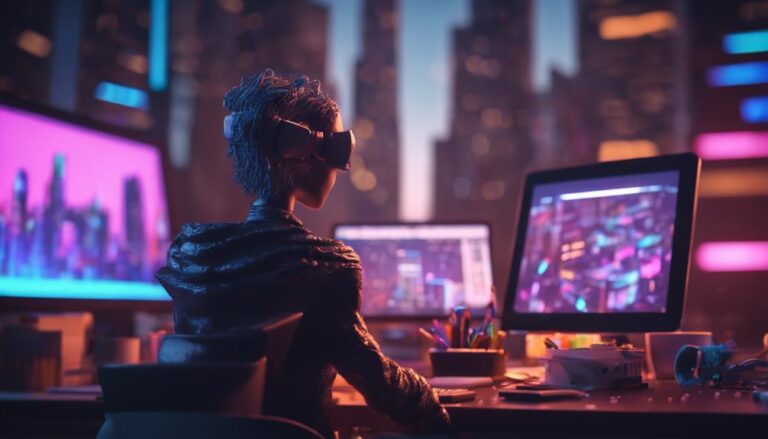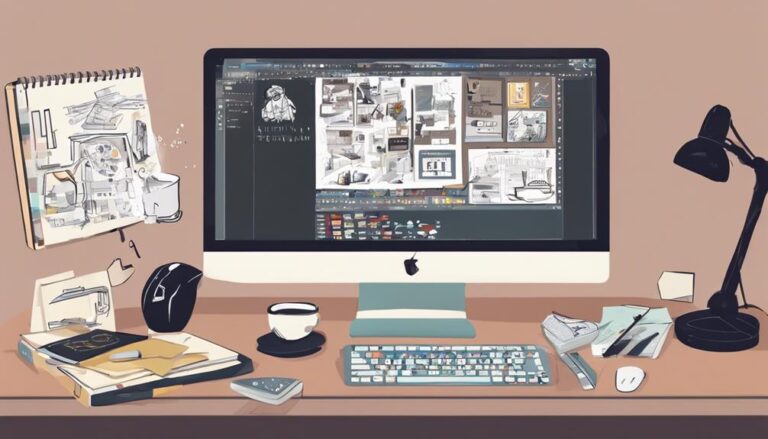What Makes a Cartoon Character Truly Unforgettable?
As you think back to your favorite childhood cartoons, you might wonder what makes certain characters stick with you long after the credits roll. Is it their quirky personality traits, their relatable struggles, or something more? As you ponder this question, you might find yourself recalling the characters that truly resonated with you – the ones that felt like old friends, with all their flaws and imperfections. But what exactly sets them apart from the rest? Let's explore the key ingredients that transform a cartoon character into an unforgettable icon, one that lingers in your memory and captures your heart.
Key Takeaways
- A cartoon character's unique personality, relatability, and lovable flaws make them memorable and authentic.
- Well-defined character arcs, growth, and transformation invest audiences in their journey and make them unforgettable.
- A character's visual identity, conveyed through thoughtful design, expresses their personality, values, and flaws, making them instantly recognizable.
- Consistency in character traits, actions, and storytelling creates cohesion and authenticity, separating beloved characters from forgettable ones.
Unique Personality Traits Matter
When you think about it, the most iconic cartoon characters aren't just memorable because of their bright colors or wacky hairstyles – it's their unique personality traits that make them truly unforgettable.
You can't help but adore SpongeBob's relentless optimism or Bugs Bunny's wisecracking sass. These quirky humor-filled characters don't just make us laugh; they make us feel like we're hanging out with an old friend.
And let's be real, it's their lovable flaws that make them relatable. Who can't identify with Daffy Duck's constant failures or Tweety Bird's naivety? Their imperfections make them human, or at least, as human as a cartoon character can get.
It's not just about being funny or cute; it's about being authentic. When you strip away the bright colors and flashy animation, it's the unique personality traits that make a cartoon character truly unforgettable.
Relatability Is Key to Success
You can create the most lovable, quirky character, but if they're not relatable, they'll fall flat with audiences.
Think about it – when was the last time you rooted for a character who'd it all together? Never, right? It's their inner struggles, their flaws, and their vulnerabilities that make them human.
And let's be real, that's what we can all relate to. We've all been there, done that, and got the t-shirt.
When your character's emotional resonance is on point, audiences will connect with them on a deeper level.
They'll laugh with them, cry with them, and cheer them on. It's not about creating a perfect character; it's about creating a real one.
One that's authentic, imperfect, and lovably flawed. So, don't be afraid to give your character some emotional baggage.
Make them struggle with self-doubt, fear, or anxiety. Make them relatable, and you'll be halfway to creating an unforgettable cartoon character.
Well-Defined Character Arcs Help
One essential aspect of crafting an unforgettable cartoon character is mapping out their transformation from clueless newbie to self-aware hero, and that's where well-defined character arcs come in.
You want to take your audience on a journey, watching your character stumble, learn, and grow. Personal growth is key to making your character relatable and likable. Think about it, who doesn't love a good underdog story?
But you can't just make your character perfect from the get-go. That's boring. Give them some serious character flaws that make them human.
Make them struggle with their own demons, and then watch them overcome them. That's what makes a character truly unforgettable. You'll be investing your audience in their journey, making them root for them from start to finish.
And let's be real, who doesn't love a good redemption story? By mapping out a well-defined character arc, you'll be creating a character that audiences will love, cry with, and remember long after the credits roll.
Iconic Design and Style Count
A cartoon character's visual identity is more than just a pretty face, it's a chance to convey their personality, values, and even their flaws through a unique design and style that screams 'iconic' from the get-go.
You can't just slap some colors together and call it a day; the design needs to be thoughtful, intentional, and instantly recognizable.
Visual simplicity is key – think Mickey Mouse's simple yet iconic ears or SpongeBob's square pants. These characters are instantly recognizable, even in silhouette.
Speaking of silhouettes, expressive ones can make or break a character's design. Can you imagine Bart Simpson without his spiky hair or Tweety Bird without his adorable tuft?
These small details make a huge difference in creating an unforgettable character. So, don't be afraid to experiment and push the boundaries of design.
Consistency Is King in Storytelling
Consistency is the secret sauce that separates beloved characters from forgettable ones, and it's what keeps audiences invested in their stories.
Let's face it, you've been there – watching a show that had so much potential, but the characters' personalities and traits changed like the wind.
It's frustrating, right? That's because consistency is key to storytelling cohesion and narrative flow.
When a character's actions and words align with their personality, it creates a sense of authenticity that keeps you hooked.
On the other hand, inconsistency is a major turnoff. It's like the writers are playing a game of character roulette, and you're left wondering what's real and what's just a plot device.
Don't even get me started on characters that suddenly develop new skills or abilities out of nowhere.
It's lazy storytelling, and it's a surefire way to lose your audience's trust.
So, if you want to create an unforgettable character, you need to stay consistent.
It's not that hard, folks!
Memorable Voice Acting Makes Impact
You think consistency is the only secret to making your characters unforgettable, but let's be real, a memorable voice can make all the difference in bringing them to life. A character's voice is more than just a sound; it's an attitude, a personality, and a distinguishing trait that sets them apart. Think about it, would SpongeBob be the same without Tom Kenny's iconic vocals? Probably not.
| Character | Voice Actor | Vocal Nuances |
|---|---|---|
| Bugs Bunny | Mel Blanc | Sassy tone, carrot-chewing sound effects |
| Bart Simpson | Nancy Cartwright | Mischievous laugh, rebellious attitude |
| Yoda | Frank Oz | Unique syntax, wise and ancient tone |
A good voice actor can bring authenticity to a character's accent, making them more relatable and believable. For example, a Scottish accent for a character from Glasgow can instantly transport the audience to the city's streets. It's not just about the voice itself, but the emotions and personality it conveys. So, don't underestimate the power of a memorable voice – it can make your character truly unforgettable.
Cultural Significance and Relevance
You're probably thinking, 'What's the big deal about cartoon characters?'
But let's be real, they're more than just colorful drawings – they're cultural ambassadors, reflecting and shaping our values, beliefs, and identities.
From Bugs Bunny's wisecracking satire to SpongeBob's optimism, these characters have become an integral part of our shared cultural heritage.
Iconic Representation Matters
As cartoon characters transcend their two-dimensional existence, they become cultural ambassadors, reflecting and influencing societal values, and their iconic representation matters because it validates, challenges, or distorts our perceptions of identity, community, and power.
You can't deny the impact of visual symbolism in shaping our understanding of the world. Take a look at the following examples:
| Character | Visual Symbolism |
|---|---|
| Mickey Mouse | Ears representing innocence and joy |
| Bart Simpson | Spiky hair symbolizing rebellion |
| SpongeBob SquarePants | Yellow skin and porous body representing optimism |
| Tweety Bird | Bright yellow feathers and large eyes signifying innocence |
| Powerpuff Girls | Bright colors and dynamic poses representing female empowerment |
These characters' iconic representations not only reflect cultural values but also influence our perceptions of identity, community, and power. They become cultural reflections, shaping our understanding of what's acceptable, desirable, and aspirational. You might think it's just a cartoon, but the impact of these characters is undeniable. They're more than just entertainment – they're cultural ambassadors, and their iconic representation matters.
Timeless Social Commentary
Cartoon characters have been slyly slipping social commentary into our Saturday morning routines, making them cultural touchstones that continue to resonate with audiences today.
You might've thought you were just watching a silly cartoon, but what you were really getting was a dose of societal critique. These characters serve as mirrors to our society, reflecting our flaws and quirks back at us.
They tackle complex issues like racism, sexism, and environmentalism in a way that's palatable to kids and adults alike. Think about it – when was the last time you saw a kids' show tackle police brutality or body positivity? It's a bold move, but it pays off.
By using satire and irony, cartoons can critique societal norms without being too on-the-nose. And let's be real, who doesn't love a good dose of sarcasm with their Saturday morning cereal?
The best part? These characters have staying power, remaining relevant long after their initial airdate. They become cultural touchstones, continuing to spark important conversations and inspire change.
Reflecting Cultural Identity
These beloved characters hold up a mirror to our cultural identity, reflecting our diversity, values, and contradictions with a precision that's both uncomfortable and mesmerizing.
You can't help but notice how they tap into your cultural roots, making you feel seen and heard. Take, for instance, anime characters that embody Japan's national pride, from samurai-inspired heroes to kawaii schoolgirls.
These characters aren't just entertaining; they're cultural ambassadors, exporting Japan's unique blend of tradition and innovation to the world.
But it's not just about national pride; these characters also reflect our cultural flaws. They show us our biases, our prejudices, and our hypocrisies.
They force us to confront the contradictions we'd rather ignore, making us squirm in our seats. And yet, we can't look away.
We're drawn to their relatability, their humanity, and their imperfections. So, the next time you watch your favorite cartoon, remember that it's not just a form of escapism – it's a reflection of yourself, your culture, and your place in the world.
Frequently Asked Questions
How Do Cartoon Characters Overcome Being Too Relatable or Cliché?
You think a cartoon character's relatability is a strength? Think again! To avoid clichés, they need to twist archetypes, making them fresh and unexpected, like a sassy princess or a cowardly superhero – it's all about subverting expectations, duh!
Can a Character Be Too Unique and Still Be Memorable?
You're worried a character's too unique, but let's be real, it's not uniqueness that's the problem – it's overthinking traits that make them a hot mess, or design flaws that scream "trying too hard."
What Role Does Nostalgia Play in a Character's Staying Power?
You think nostalgia is just about sentimental value, but it's rooted in child psychology – it's a legit emotional connection. And let's be real, cultural significance plays a huge role; it's why you still rock your old SpongeBob tee.
How Much Character Development Is Too Much or Too Little?
You're walking a tightrope with character development – too little and they're flat, too much and they're exhausting. Hit the sweet spot with balanced backstory and meaningful character arcs, or risk losing your audience's attention span.
Can a Character's Popularity Be Revived After a Decline?
"Want to revive a character's waning popularity? You'll need a solid fan revival strategy, pronto! Don't rely on nostalgic reboots alone; inject fresh twists, engaging storylines, and clever merchandising to reignite the spark and win back fans' hearts."
Conclusion
So, you want to create a cartoon character that'll be etched in our minds forever?
Well, it's not rocket science – just give them a personality that's weirdly relatable, a backstory that's messy and real, and a design that's instantly iconic.
Oh, and don't forget a voice that's catchy and consistent storytelling that doesn't suck.
And, yeah, if you can tap into our cultural psyche, that's a bonus.
Do all that, and you might just create a character that'll outlive us all.







